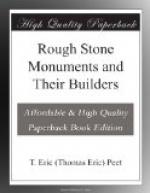Finally Halsaflieni has yielded several steatopygous figurines. Some of these resemble those of Hagiar Kim, but two are of rather different type. Each of these represents a female lying on a rather low couch. In the better preserved of the two she lies on her right side, her head on a small uncomfortable-looking pillow. The upper part of her body is naked, but from the waist downwards she is clad in a flounced skirt which reaches to the ankles. The other figurine is very similar, but the woman here is face downwards on the couch.
The bodies themselves were so damaged with damp that only ten skulls could be saved whole. These, however, afford very valuable anthropological evidence. They have been carefully measured by Dr. Zammit, and they prove to belong to a long-headed (dolichocephalic) type usual among the neolithic races of the Mediterranean.
We have still to discuss the purpose of this great complex of underground chambers and passages. It is quite clear that its eventual fate was to be used as a burial place for thousands of individuals, but it is far from certain that this was the purpose for which it was built. The existence of the central chamber, with its careful work and laborious imitation of an open-air ‘temple,’ is against this interpretation. It has therefore been suggested that the hypogeum was meant for a burial place, and that the central chamber was the chapel or sanctuary in which the funeral rites were performed, after which the body was buried in one of the smaller rooms. This, however, does not explain the presence of burials in the chapel itself, and it is far more likely that it was only after Halsaflieni had ceased to be used for its original purpose that it was seized upon as a convenient place for burial.
The question of the date of the Maltese megalithic buildings is a difficult one. It is true that no metal has been found in them, and that we can therefore speak of them as belonging to the neolithic age. But the neolithic age of Malta need not be parallel in date with that of Crete for example. It is extremely probable that Malta lay outside the main currents of civilization, and that flint continued to be used there long after copper had been adopted by her more fortunate neighbours.
CHAPTER VIII
THE DOLMENS OF ASIA
In the south-east of Europe lie three groups of dolmens which are no doubt in origin more closely connected with those of Asia than with those of the rest of Europe. The first group lies in Bulgaria, where no less than sixty dolmens have been found north of Adrianople. The second consists of a few dolmens which still remain in the Crimea, and the third lies in the Caucasus in two divisions, one to the south-east and the other to the south-west of the town of Ekaterinodar. These last are made of slabby rock, and thus have a finished appearance. A dolmen near Tzarskaya has a small semicircular hole at the bottom of one of its end-slabs, while another in the valley of Pehada has sides consisting of single blocks, placed so as to slant inwards considerably, and a circular hole in the centre of the slab which closes one of its ends.




